COSPAR ID 1971-032A Crew 3 Width ~4 m Mass 18,420 kg Distance travelled 118.602524 billion m Dates 19 Apr 1971 – 11 Oct 1971 | Call sign Salyut 1 Length ~20 m Launch date 19 April 1971 Orbital period 1.5 hours Apogee 222,000 m | |
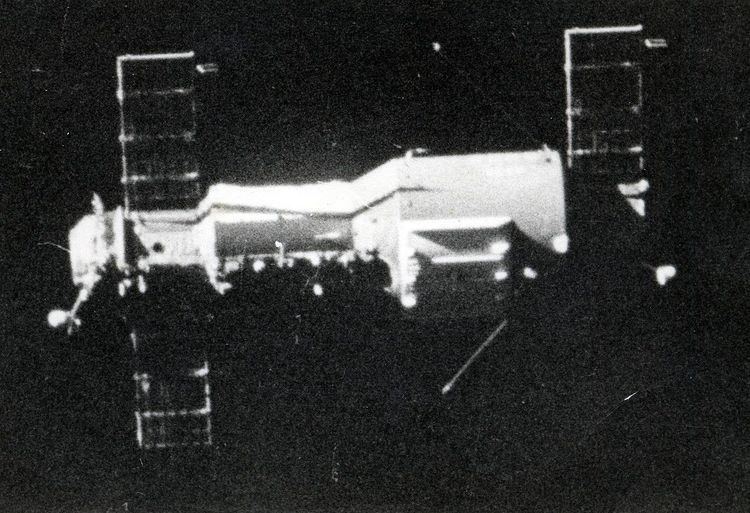 | ||
Similar Salyut 2, Salyut 3, Salyut 7, Salyut 4, Salyut 5 | ||
Salyut 1 orbiter space flight simulator 2010
Salyut 1 (DOS-1) (Russian: Салют-1; English translation: Salute 1) was the first space station of any kind, launched by the Soviet Union on April 19, 1971. More stations followed in the Salyut program, and heritage of that space station program is still in use on the ISS.
Contents
- Salyut 1 orbiter space flight simulator 2010
- Summary salyut 1 the first ever spacestation
- Structure
- Transfer compartment
- Main compartment
- Auxiliary compartments
- Orion 1 Space Observatory
- Specifications
- Soyuz 10
- Soyuz 11
- Re entry
- References
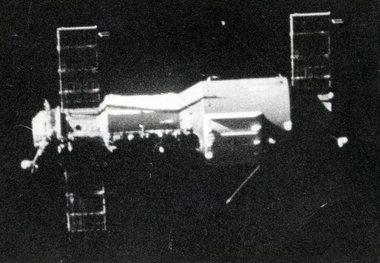
Salyut 1 originated as a modification of the military Almaz space station program then in development. After the landing of Apollo 11 on the Moon in July 1969, the Soviets began shifting the primary emphasis of their manned space program to orbiting space stations, with a possible lunar landing later in the 1970s if the N-1 booster became flight-worthy (which it didn't). One other motivation for the space station program was a desire to one-up the US Skylab program then in development. The basic structure of Salyut 1 was adapted from the Almaz with a few modifications and would form the basis of all Soviet space stations through Mir.
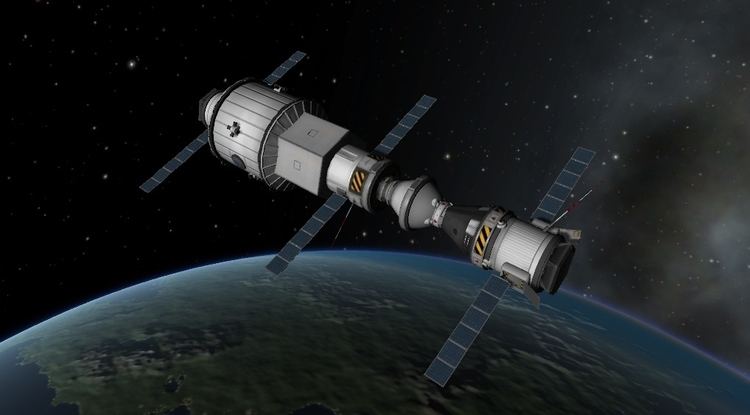
Civilian Soviet space stations were internally referred to as "DOS" stations, although publicly, the Salyut name was used for all Almaz and DOS stations. Several military experiments were nonetheless carried on Salyut 1, including the OD-4 optical visual ranger, the Orion ultraviolet instrument for characterizing rocket exhaust plumes, and the highly classified Svinets radiometer.
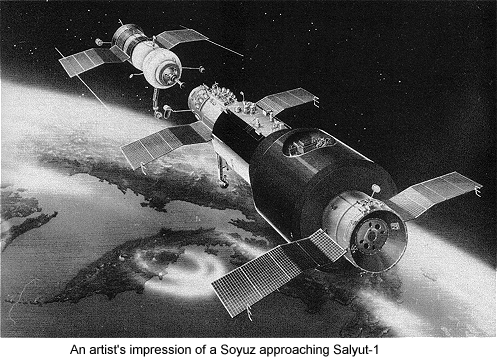
Construction of Salyut 1 began in early 1970 and after nearly a year, it was shipped to the Baikonur Cosmodrome. Some remaining assembly work had yet to be done and this was completed at the launch center.

Launch was planned for April 12, 1971 to coincide with the 10th anniversary of Yuri Gagarin's flight on Vostok 1, but technical problems delayed it until the 19th. The first crew launched later in the Soyuz 10 mission, but they ran into troubles while docking and were unable to enter the station; the Soyuz 10 mission was aborted and the crew returned safely to Earth. Its second crew launched in Soyuz 11 and remained on board for 23 days. This was the first time in the history of spaceflight that a space station had been manned, and a new record in time spent in space. This success was, however, overshadowed when the crew was killed during re-entry, as a pressure-equalization valve in the Soyuz 11 re-entry capsule had opened prematurely, causing the crew to asphyxiate. After this accident, missions were suspended while the Soyuz spacecraft was redesigned. The station was intentionally destroyed by de-orbiting it after six months in orbit, because it ran out of fuel before a redesigned Soyuz spacecraft could be launched to it.
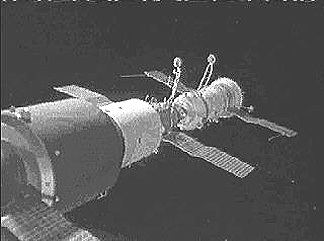
Summary salyut 1 the first ever spacestation
Structure
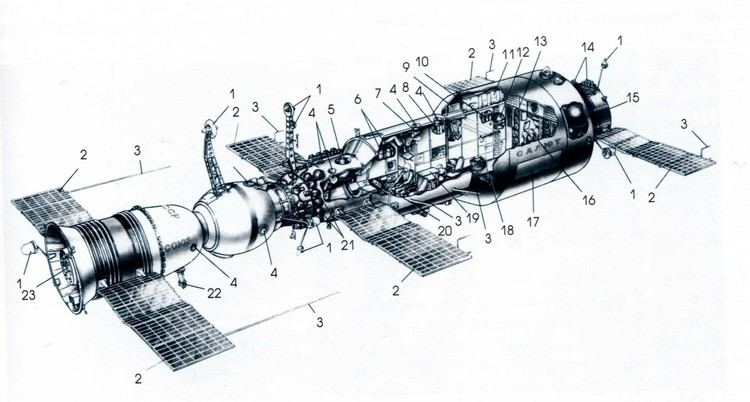
At launch, the announced purpose of Salyut was to test the elements of the systems of a space station and to conduct scientific research and experiments. The craft was described as being 20 m in length, 4 m in maximum diameter, and 99 m³ in interior space with an on-orbit dry mass of 18,425 kg. Of its several compartments, three were pressurized (100 m³ total), and two could be entered by the crew.
Transfer compartment
The transfer compartment was equipped with the only docking port of Salyut 1, which allowed one Soyuz 7K-OKS spacecraft to dock. It was the first use of the Soviet "probe and drogue" type docking system that allowed internal crew transfer, a system that is in use today. The docking cone had a 2 m front diameter and a 3 m aft diameter.
Main compartment
The second, and main, compartment was about 4 m in diameter. Televised views showed enough space for eight big chairs (seven at work consoles), several control panels, and 20 portholes (some obstructed by instruments).
Auxiliary compartments
The third pressurized compartment contained the control and communications equipment, the power supply, the life support system, and other auxiliary equipment. The fourth, and final, unpressurized compartment was about 2 m in diameter and contained the engine installations and associated control equipment. Salyut had buffer chemical batteries, reserve supplies of oxygen and water, and regeneration systems. Externally mounted were two double sets of solar cell panels that extended like wings from the smaller compartments at each end, the heat regulation system's radiators, and orientation and control devices.
Salyut 1 was modified from one of the Almaz airframes. The unpressurized service module was the modified service module of a Soyuz craft.
Orion 1 Space Observatory
The astrophysical Orion 1 Space Observatory designed by Grigor Gurzadyan of Byurakan Observatory in Armenia, was installed in Salyut 1. Ultraviolet spectrograms of stars were obtained with the help of a mirror telescope of the Mersenne system and a spectrograph of the Wadsworth system using film sensitive to the far ultraviolet. The dispersion of the spectrograph was 32 Å/mm (3.2 nm/mm), while the resolution of the spectrograms derived was about 5 Å at 2600 Å (0.5 nm at 260 nm). Slitless spectrograms were obtained of the stars Vega and Beta Centauri between 2000 and 3800 Å (200 and 380 nm). The telescope was operated by crew member Viktor Patsayev, who became the first man to operate a telescope outside the Earth’s atmosphere.
Specifications
Soyuz 10
After taking 24 h for rendezvous and approach, Soyuz 10 soft-docked with Salyut on April 23 and remained for 5.5 h. Hard-docking was unsuccessful due to an unforeseen design flaw in the Soyuz's autopilot. The crew could not enter the station and had to abort the mission.
Soyuz 11
Soyuz 11 required 3 h 19 min on June 7 to complete docking. The crew transferred to Salyut and their mission was announced as:
On June 29, after 23 days and flying 362 orbits, the mission was cut short due to problems aboard the station, including an electrical fire. The crew transferred back to Soyuz 11 and reentered the Earth's atmosphere. The capsule parachuted to a soft landing in Kazakhstan, but the recovery team opened the hatch to find all three crew members dead in their couches. An inquest found that a pressure relief valve had malfunctioned during re-entry leading to a loss of cabin atmosphere. Pressure suits had not been used on Soviet manned spacecraft since the Vostok program.
Re-entry
Salyut 1 was moved to a higher orbit in July–August 1971 to ensure that it would not be destroyed prematurely through orbital decay. In the meantime, Soyuz capsules were being substantially re-designed to allow pressure suits to be worn during launch, docking maneuvers, and re-entry. The Soyuz redesign effort took too long however, and by September, Salyut 1 was running low on attitude control gas. It was decided to conclude the station's mission and on October 11, the main engines were fired for a deorbit maneuver. After 175 days, the world's first space station burned up over the Pacific Ocean.
Pravda (October 26, 1971) reported that 75% of Salyut 1's studies were carried out by optical means and 20% by radio-technical means, while the remainder involved magneto-metrical, gravitational, or other measurements. Synoptic readings were taken in both the visible and invisible parts of the electromagnetic spectrum.
